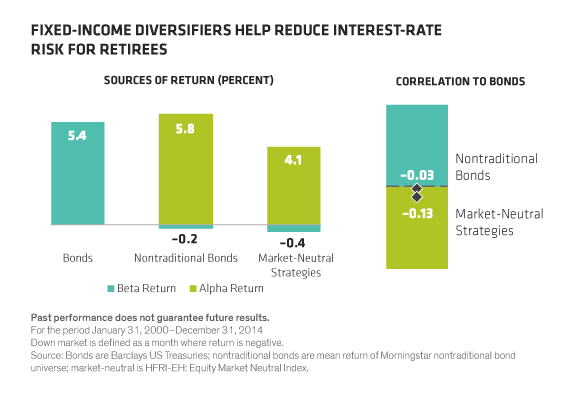Will the Fed start raising interest rates in October, December or next year? It should make no difference to building a successful target-date glide path for the next decade and beyond.
Target-date glide paths are fundamentally designed for decades-long investing for retirement. And while there are strategies we can incorporate for muting short-term market volatility, the most important “term” for target-date funds is how close or far away each participant is from retirement.
We’ve researched when and how to enhance the equity portion of a target-date glide path. We’ve also analyzed the impact of including real assets to offset the very real probability of rising inflation over the next decade. But the biggest area that can use a boost from diversification is the bond portion of the glide path. This is especially true as participants head toward and into retirement.
In those later stages of the glide path, participants need to reduce the interest-rate sensitivity of their bond allocation. We see several ways to increase diversification in the fixed-income allocation.
1. High-Income Strategies, like high-yield and emerging-market bonds, are effective diversifiers for participants in the midlife stage. That’s because these strategies offer higher returns than traditional bonds. They also have less interest-rate sensitivity than a core bond allocation.
2. Global Bond Strategies hedged to the US dollar can diversify interest-rate risk across many geographies and reduce the impact of a sharp increase in US rates.
3. Low-Duration Strategies added later in life help reduce interest-rate sensitivity and volatility. However, they do so at a cost to long-term returns.
4. Fixed-Income Diversifiers are another underused alternative. These active strategies are designed to generate stable returns without being sensitive to the interest-rate environment. It’s because their returns are driven mostly by manager skill rather than broad market exposure. That’s appealing as we enter a period that’s likely to see rising rates. Nontraditional bonds and market-neutral strategies are two types of diversifiers (Display).

Nontraditional bonds, which focus on absolute returns, tend to have fewer constraints than traditional bond funds. Some nontraditional bond strategies manage interest-rate sensitivity in various ways. They may include high-yield bonds, securitized loans, foreign sovereign bonds and corporate debt. Equity market-neutral strategies generally take both long and short equity positions and attempt to hedge out all market exposure. These funds work to provide small but steady returns in all market conditions.
Nontraditional bonds and market-neutral equities use alternative approaches to generate returns. They’re uncorrelated to the broad bond market, and they provide important diversification when rates rise. As the display shows, the correlation of these strategies to US Treasury bonds (or interest-rate risk) has been virtually zero for the past 15 years.
Before incorporating these strategies into a target-date glide path, it’s important to determine when and where they best fit. We believe that they’re best used as a substitute for some bond exposure late in the glide path. But the “who” is just as important as the “when” and “where.” These active strategies don’t depend on market movement (beta) as much as they do on individual manager skill (alpha). So, careful manager selection is key. This filtering process sifts through managers with diverse approaches and strategies, and makes sure the return source will last.
The views expressed herein do not constitute research, investment advice or trade recommendations and do not necessarily represent the views of all AB portfolio-management teams.
"Target date" in a fund's name refers to the approximate year when a plan participant expects to retire and begin withdrawing from his or her account. Target-date funds gradually adjust their asset allocation, lowering risk as a participant nears retirement. Investments in target-date funds are not guaranteed against loss of principal at any time, and account values can be more or less than the original amount invested—including at the time of the fund's target date. Also, investing in target-date funds does not guarantee sufficient income in retirement.